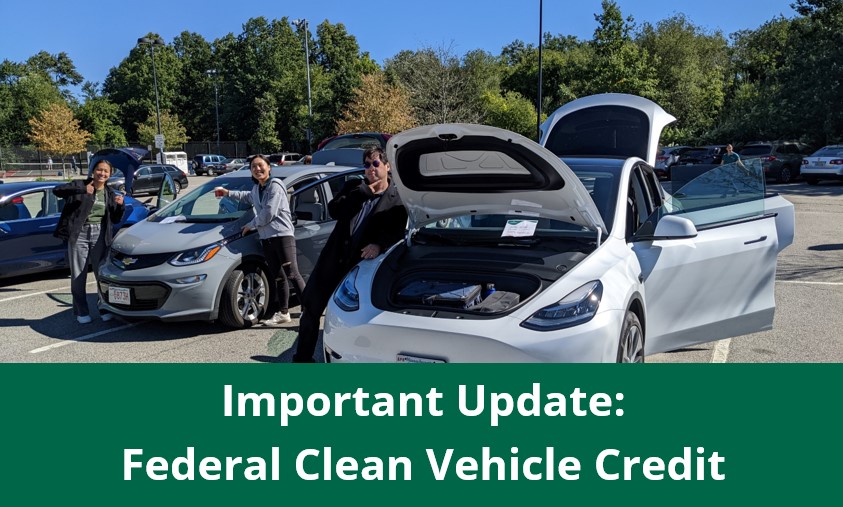Green Energy Consumers' Statement on MOR-EV Program Extension
On December 6, 2018, the state of Massachusetts announced that it will extend the popular electric vehicle (EV)...
 The Inflation Reduction Act (IRA) signed into law by President Biden in August 2022 fundamentally changed the structure of the federal tax credit for electric vehicles (EVs). Now, we’ve learned that the U.S. Treasury is delaying implementation of one key piece of the IRA, which means more vehicle models than expected may be eligible for incentives for a short time at the beginning of 2023.
The Inflation Reduction Act (IRA) signed into law by President Biden in August 2022 fundamentally changed the structure of the federal tax credit for electric vehicles (EVs). Now, we’ve learned that the U.S. Treasury is delaying implementation of one key piece of the IRA, which means more vehicle models than expected may be eligible for incentives for a short time at the beginning of 2023.
If you are not yet familiar with all of the changes to the federal tax credit implemented by the IRA, we have a couple of resources for you to review. There’s this blog we published in August 2022 that outlines the details of the new clean vehicle credit and this page on our Drive Green website that explains both the federal and state-level incentives for EVs. If you prefer a video, here’s a clip from one of our webinars on the IRA that focuses just on the transportation aspects.
On December 19, the U.S. Treasury Department announced that is delaying until March the release of the guidance automakers need in order to prove their compliance with the battery requirements of the IRA.
As a refresher, per the IRA, the Clean Vehicle Credit amount any particular vehicle model qualifies for depends on whether the manufacturer meets strict battery requirements:
Though the IRA is clear on the percentage requirements for minerals and battery value, it is NOT clear on how a manufacturer will verify to the federal government whether they meet those requirements. What paperwork do they need to submit? How are the values calculated? All of that will be outlined in the guidance from the Treasury, which now won’t come out until the spring.
Why the delay? Simply put, the Treasury needs more time to translate complicated requirements into detailed instructions.
Effectively, this means that vehicles that might not meet the battery requirements in the IRA will be eligible for the Clean Vehicle Credit for a short time in 2023 – between January 1 and whenever the Treasury finalizes the guidance. (The other provisions in the IRA, like the income cap and price cap, will still take effect on January 1.)
For example, the well-loved Chevrolet Bolt will be even more affordable starting January 1. Previously, General Motors had signaled that they believe the Bolt would qualify for half the federal tax credit, at $3,750. But starting January 1 and until the battery requirements kick in, the Bolt should qualify for the full $7,500. The Bolt’s starting MSRP of $25,600 is lower than most EVs – and most new vehicles, period!
.jpg?width=4032&height=3024&name=QARI%20Drives%20Green%20August%20Moon%20Festival%208.21.22%20red%20Bolt%20open%20doors%20blue%20beach%20umbrella%20people%20talking%20(1).jpg) The well-loved Chevrolet Bolt at this year's August Moon Festival in Quincy
The well-loved Chevrolet Bolt at this year's August Moon Festival in Quincy
As always, we want to help you make the switch from your gas-powered car to an EV. We will update our Drive Green shopping tool with the new Clean Vehicle Credit information on January 1, so you can compare different car models and find the right one for you. Have questions? Email us at drivegreen@greenenergyconsumers.org. We’re here to help!
On December 6, 2018, the state of Massachusetts announced that it will extend the popular electric vehicle (EV)...
It’s tax season, and though you probably didn’t want to fill out another IRS form, Form 8936 (Qualified Plug-in...
Comments